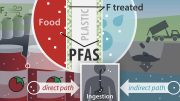
A recent study reveals that supposedly safe replacement PFAS used in food packaging break down into toxic compounds, contaminating food and the environment. This challenges the PFAS industry’s claims about the safety of polymeric PFAS, suggesting that the best course of action is to eliminate the entire class of PFAS from non-essential uses.
A study recently published in Environmental Science & Technology Letters suggests that the per- and polyfluoroalkyl substances (PFAS) once considered safe for use in food packaging break down into toxic PFAS that can seep into our food and environment.
In light of the dangers posed by smaller PFAS molecules like PFOA and PFOS in food-contact materials, numerous companies have shifted to using larger polymeric PFAS in their fast-food packaging, such as wrappers and bowls, to make them resistant to water and grease. These polymeric PFAS are touted as being “safer” options as they are deemed to be inert and too heavy to leach out of products.
However, this study provides the first evidence that polymeric PFAS used in food packaging break down into smaller molecules that are still harmful and can leach into food and the environment.
“It’s clear that polymers aren’t the harmless loophole the PFAS industry was counting on them to be,” said Marta Venier, co-author and professor at Indiana University. “Their use in food packaging still leads to harmful and persistent PFAS contaminating the food we eat, and after it’s thrown away, our air and drinking water.”
The researchers tested 42 paper-based wrappers and bowls collected from fast-food restaurants in Toronto. A PFAS that is known to be toxic—6:2 FTOH (6:2 fluorotelomer alcohol)—was the most abundant compound detected in these samples. The polymeric PFAS in the samples can transform into this compound, thereby adding to a consumer’s exposure to it.
Critically, the researchers found that the concentration of PFAS declined by up to 85% after storing the products for two years under normal conditions (at room temperature and in the dark). Much of these losses were consistent with the breakdown of the polymeric PFAS added to the fast-food packaging. These results contradict claims that polymeric PFAS are immobile and do not create exposure risks.
Some smaller PFAS molecules have been associated with a wide range of serious health harms, from cancer to obesity to more severe COVID-19 outcomes, and they contaminate the drinking water of many millions. Only a small fraction of the thousands of PFAS have been tested for toxicity, and all PFAS (including polymers) are either extremely persistent in the environment or break down into extremely persistent PFAS.
These concerns have prompted 11 U.S. states to ban PFAS from most food packaging, and major chains like Mcdonald’s and Chick-fil-A have committed to becoming PFAS-free by 2025.
“There has been great progress toward phasing out PFAS, polymers included, from fast-food packaging in the U.S.,” said co-author Arlene Blum, Executive Director of the Green Science Policy Institute. “However, this study calls into question the safety of polymeric PFAS for many of its uses. The best course of action to protect our children and future generations is to eliminate the whole class of PFAS from all non-essential uses, from food packaging to rain jackets, as soon as possible.”
Reference: “Per- and Polyfluoroalkyl Substances in Canadian Fast Food Packaging” by Heather Schwartz-Narbonne, Chunjie Xia, Anna Shalin, Heather D. Whitehead, Diwen Yang, Graham F. Peaslee, Zhanyun Wang, Yan Wu, Hui Peng, Arlene Blum, Marta Venier and Miriam L. Diamond, 28 March 2023, Environmental Science & Technology Letters.
DOI: 10.1021/acs.estlett.2c00926
The study was funded by Environment and Climate Change Canada, the Great Lakes Protection Initiative, the Natural Sciences and Engineering Research Council of Canada, the Green Science Policy Institute, and the European Union under the Horizon 2020 Research and Innovation Programme.









When will they learn?
Waxed paper worked for centuries. Industry wanted convenience and cheap.
So they said the same thing about lead d gasoline as they ignored testing where every animal expis d to it had life altering side effects… Even linked it to agression…. And they test these things all the time so don’t believe this crap about oh we thought it was safe…. Literally all banned in other countries that even out people tested is ok here yet causes health issues in animals with far less exposure than we all get as some things even accumulate damage over time and can effect generations down the line… They knew. They just saw “acceptable risks” worse than just keeping it all natural. Hell even plastic carries a health risk as it’s made of toxic stuff… Yet sex toys, food packaging, car interiors, drinking cups… All made of plastic and we get exposed to all the stuff. Stuff they tested and found problems with as they tested them by themselves. As we get exposed to hundreds of things daily. They know how bad it all is… Acceptable risk factors tho and ignore the far greater exposure.
And heck all of the worlds major health issues. Guess what things carry those risks with them… Most of what’s said is safe. Even processed foods could be responsible for high blood pressure, insomnia, lack of energy and other issues… And they expect us to not notice. Like how many deaths are from stuff they say is safe and they write off the death as natural causes… Cause most in America and the world probably suffer some effect of the stuff around us.Some more than others at faster rates. Can’t be a coincidence everything thats a side effect is in the rise right along with production of the stuff. You know why they don’t really look into it tho… How pissed would you be if they came out and said 90% of those that die from this or that most likely were effected by stuff that caused those things and their early death. Avoidable early deaths…
Why can’t they just use wax on food storage containers??? Real wax by the way.
We still have HYDROGINATED oils, despite an FDA ban.
Read label on Kraft peanut butter. But natural instead.